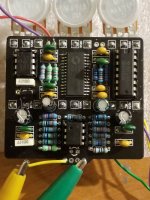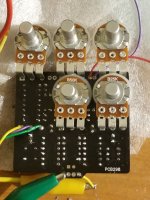p_wats
Well-known member
Here I am with another FV-1 based troubleshooting thread, alas.
I've got a populated Deflector PCB here that works fine for a while, then the wet signal cuts out---sometimes a quick stop, others an intermittent sputter, but the effect always stops at some point.
The key thing to note here is that I soldered the FV-1 myself (after stealing the chip that had been on this board to try and troubleshoot another build---the less we speak of that the better, for now). This isn't my first time soldering an FV-1 and the joints look good in a magnifier.
It's a brand new chip. I've fluxed and reflowed each pin carefully, which always seems to bring the pedal back to life, but the most I've gotten out of it is about 15 minutes of playing before it sputtered out again.
I assume that points to an intermittent connection with one (or more) of the pins, but I've already fluxed and reflowed the joints so many times (including the rest of the pedal) that I'm curious if there's something else I may want to try.
When it's working it sounds great (though there is a whine during a portion of the Density pot sweep, but I can work on that later).
Anyone ever run into something similar before?
I've got a populated Deflector PCB here that works fine for a while, then the wet signal cuts out---sometimes a quick stop, others an intermittent sputter, but the effect always stops at some point.
The key thing to note here is that I soldered the FV-1 myself (after stealing the chip that had been on this board to try and troubleshoot another build---the less we speak of that the better, for now). This isn't my first time soldering an FV-1 and the joints look good in a magnifier.
It's a brand new chip. I've fluxed and reflowed each pin carefully, which always seems to bring the pedal back to life, but the most I've gotten out of it is about 15 minutes of playing before it sputtered out again.
I assume that points to an intermittent connection with one (or more) of the pins, but I've already fluxed and reflowed the joints so many times (including the rest of the pedal) that I'm curious if there's something else I may want to try.
When it's working it sounds great (though there is a whine during a portion of the Density pot sweep, but I can work on that later).
Anyone ever run into something similar before?



